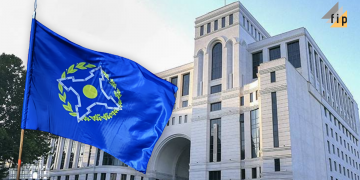On October 28, an extraordinary session of the CSTO Collective Security Council was held, during which the report of the CSTO Secretary General was discussed resulting from the activities of the mission sent to Armenia after the Azerbaijani military aggression of September 13.
Fact Investigation Platform found a number of false statements in the speech of the Belarusian President Alexander Lukashenko who participated in the session, as well as in the reportage of the Belarusian state TV channel covering his speech.
Azerbaijan attacked Armenian settlements: False statements by Lukashenko
During his speech, the President of Belarus not only does not record that the Azerbaijani armed forces invaded the sovereign territory of the Republic of Armenia in his speech, but also claims that the hostilities took place on the Armenian-Azerbaijani border, far from settlements.
“What are you waging war for on those 2000 meter high mountains? 300 people were killed where people do not live,” said the President of Belarus.
Earlier, FIP.am addressed to the attempts of the Russian First Channel and the Foreign Ministry of Kazakhstan, RA’s partner in the CSTO, to falsify the image of Azerbaijani aggression, stating that what happened was not a border incident, far from settlements, as the latter claimed, but an attack that was deliberately aimed at the civilian population and vital civilian infrastructure.
FIP.am also addressed the distance of such settlements targeted by the Azerbaijani attack from the Armenian-Azerbaijani border. For example, Sotk settlement of Gegharkunik region, according to the Google Earth satellite map, is located more than 8.5 km inside the border of Armenia, Verishen settlement of Syunik region – more than 9 km, Karashen settlement – more than 3 km, Jermuk city – 13 km inside the border.
At the same time, the Armenian side officially reported 3 killed and 7 wounded civilians.
Thus, Lukashenko’s claim that people do not live in the arena of hostilities is false. Dozens of Armenian settlements were targeted during the Azerbaijani aggression.
By whose efforts was the ceasefire established? Statements contradicting Yerevan by Baku and CSTO partners
Commenting on the meeting of the CSTO Council, the commentator of the Belarusian TV channel first claimed that it was convened on the basis of urgency. Meanwhile, the extraordinary session was held almost two months after the Azerbaijani aggression of September 13, therefore it could not be characterized as urgent in any way.
Then the commentator, referring to the speech of the Russian President Vladimir Putin, who participated in the session, said that the latter stated that “due to Moscow’s mediation efforts, the outbreak of another Armenian-Azerbaijani war was prevented,” despite the fact that the official Kremlin does not report such a statement made during the session by the Russian President.
Earlier, the chair of the Federation Council Committee on Foreign Affairs, Grigory Karasin, made a similar claim from the Russian side.
The commentator also reports that Lukashenko also attributed the cessation of the September hostilities to Moscow’s efforts, at the same time expressing his opposition to the deployment of EU and OSCE observation missions on the Armenian-Azerbaijani border.
Earlier, on October 13, at the regular session of the Council of Heads of State of CIS in Astana, the President of Azerbaijan Ilham Aliyev also claimed that the ceasefire agreement was reached with the efforts of the Russian side, complaining that “some people attribute them to other countries.”
However, during the press conference held after the meeting with the delegation led by the Speaker of the US House of Representatives, Nancy Pelosi, who arrived in Armenia on an official visit on September 18, RA NA Speaker Alen Simonyan declared that the Azerbaijani aggression was stopped due to the US efforts.
“We are grateful to the US for its efforts, through whose mediation a fragile cease-fire agreement was reached on September 14. We are also grateful to the US authorities, including many congressmen, for giving a clear qualification to Azerbaijan’s actions,” said Simonyan.
Thus, during the meeting of the CSTO Council held almost two months after the Azerbaijani aggression on September 13, the leaders of the member states did not record the fact of Azerbaijan’s invasion of the sovereign territory of Armenia. Moreover, the leader of Belarus, one of the member states of the military organization, presented the Azerbaijani aggression as a border incident far from the settlements.
During the same session and before, the statements of the representatives of some CSTO member states and the President of Azerbaijan regarding the mediator of the cease-fire coincide: “it is the Russian side,” at the same time, they contradict the position of the Armenian side, according to which the hostilities have stopped at the mediation of the American party when the latter officially recorded the aggression of Azerbaijan.
Nane Manasyan

 FACTOMETER
FACTOMETER










